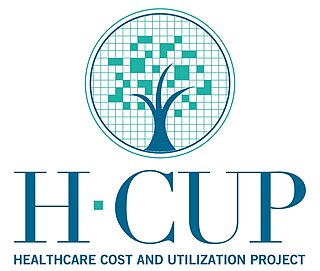
The United States Census Bureau (USCB), officially the Bureau of the Census, is a principal agency of the U.S. Federal Statistical System, responsible for producing data about the American people and economy. The Census Bureau is part of the U.S. Department of Commerce and its director is appointed by the President of the United States. Currently, Rob Santos is the Director of the U.S. Census Bureau and Ron Jarmin is the Deputy Director of the U.S. Census Bureau
A trauma center, or trauma centre, is a hospital equipped and staffed to provide care for patients suffering from major traumatic injuries such as falls, motor vehicle collisions, or gunshot wounds. A trauma center may also refer to an emergency department without the presence of specialized services to care for victims of major trauma.
The American Academy of Pediatrics (AAP) is the largest professional association of pediatricians in the United States. It is headquartered in Itasca, Illinois, and maintains an office in Washington, D.C. The AAP has published hundreds of policy statements, ranging from advocacy issues to practice recommendations.

Freedom of information is freedom of a person or people to publish and have access to information. Access to information is the ability for an individual to seek, receive and impart information effectively. This sometimes includes "scientific, indigenous, and traditional knowledge; freedom of information, building of open knowledge resources, including open Internet and open standards, and open access and availability of data; preservation of digital heritage; respect for cultural and linguistic diversity, such as fostering access to local content in accessible languages; quality education for all, including lifelong and e-learning; diffusion of new media and information literacy and skills, and social inclusion online, including addressing inequalities based on skills, education, gender, age, race, ethnicity, and accessibility by those with disabilities; and the development of connectivity and affordable ICTs, including mobile, the Internet, and broadband infrastructures".
The European Bioinformatics Institute (EMBL-EBI) is an intergovernmental organization (IGO) which, as part of the European Molecular Biology Laboratory (EMBL) family, focuses on research and services in bioinformatics. It is located on the Wellcome Genome Campus in Hinxton near Cambridge, and employs over 600 full-time equivalent (FTE) staff. Institute leaders such as Rolf Apweiler, Alex Bateman, Ewan Birney, and Guy Cochrane, an adviser on the National Genomics Data Center Scientific Advisory Board, serve as part of the international research network of the BIG Data Center at the Beijing Institute of Genomics.
A credit bureau is a data collection agency that gathers account information from various creditors and provides that information to a consumer reporting agency in the United States, a credit reference agency in the United Kingdom, a credit reporting body in Australia, a credit information company (CIC) in India, a Special Accessing Entity in the Philippines, and also to private lenders. It is not the same as a credit rating agency.

Children's National Hospital is a nationally ranked, freestanding, 323-bed, pediatric acute care children's hospital located in Washington D.C. It is affiliated with the George Washington University School of Medicine and the Howard University College of Medicine. The hospital provides comprehensive pediatric specialties and subspecialties to infants, children, teens, and young adults aged 0–21 throughout the region. The hospital features an ACS verified level I pediatric trauma center, the only one in the District of Columbia. Its pediatric intensive care unit and neonatal intensive care units serve the region. The hospital also has a rooftop helipad for critical pediatric transport.

The Detroit Medical Center (DMC) is a for-profit alliance of hospitals that encompasses over 2,000 licensed beds, 3,000 affiliated physicians and over 12,000 employees. Located in Midtown Detroit, the DMC is affiliated with medical schools from Wayne State University and Michigan State University. Detroit Medical Center hospitals are staffed by physicians from the Michigan State University College of Osteopathic Medicine and the Wayne State University School of Medicine, the largest single-campus medical school in the United States and the nation's fourth largest medical school overall. The Detroit Medical Center is fully accredited by the Joint Commission on Accreditation of Healthcare Organizations.

UW Health University Hospital is a 614-bed academic regional referral center with 127 outpatient clinics, located on the western edge of the University of Wisconsin–Madison's campus in Madison, Wisconsin. It is an American College of Surgeons designated Level I adult and pediatric trauma center, one of only two in Wisconsin.

Intermountain Primary Children's Hospital (PCH) is a nationally ranked pediatric acute care children's teaching hospital located in Salt Lake City, Utah. The hospital has 289 pediatric beds and is affiliated with the University of Utah School of Medicine. The hospital is a member of Intermountain Health and is the only children's hospital in the network. The hospital provides comprehensive pediatric specialties and subspecialties to infants, children, teens, and young adults aged 0–21 throughout the Salt Lake City and outer region. PCH also sometimes treats adults that require pediatric care. PCH is a ACS verified Level 1 Pediatric Trauma Center and is the largest providers of pediatric health services in the state. The hospital serves the states of Utah, Nevada, Idaho, Montana, and Wyoming, yielding an enormous geographic catchment area of approximately 400,000 square miles. The hospital is one of the only pediatric hospitals in the region.

President of the United States George W. Bush signed the Food and Drug Administration Amendments Act of 2007 (FDAAA) on September 27, 2007. This law reviewed, expanded, and reaffirmed several existing pieces of legislation regulating the FDA. These changes allow the FDA to perform more comprehensive reviews of potential new drugs and devices. It was sponsored by Reps. Joe Barton and Frank Pallone and passed unanimously by the Senate.

OSF Saint Francis Medical Center, located in Peoria, Illinois, United States, is a teaching hospital for the University of Illinois College of Medicine at Peoria and part of the OSF Healthcare System. The center, which is the largest hospital in the Peoria metropolitan area and in central Illinois, is designated by the state of Illinois as the Level I adult and pediatric regional trauma center for a 26-county region in mid-Illinois.

Dayton Children's Hospital stylized as Dayton Children's formerly The Children's Medical Center of Dayton is a pediatric acute care children's teaching hospital located in Dayton, Ohio. The hospital has 181 pediatric beds and is affiliated the Boonshoft School of Medicine at Wright State University. The hospital provides comprehensive pediatric specialties and subspecialties to infants, children, teens, and young adults aged 0–21 throughout western Ohio and the surrounding states. Dayton Children's Hospital is also an ACS verified Level 1 Pediatric Trauma Center.
BJC HealthCare is a non-profit health care organization based in St. Louis, Missouri. BJC includes two nationally recognized academic hospitals – Barnes–Jewish Hospital and St. Louis Children's Hospital, which are both affiliated with the Washington University School of Medicine.

The Healthcare Cost and Utilization Project is a family of healthcare databases and related software tools and products from the United States that is developed through a Federal-State-Industry partnership and sponsored by the Agency for Healthcare Research and Quality (AHRQ).
The Emergency Medical Services for Children (EMSC) program is a US federal government health initiative. It is administered by the U.S. Department of Health and Human Services’ Health Resources and Services Administration (HRSA), and the Maternal and Child Health Bureau (MCHB). Its aim is to reduce child and youth disability and death due to severe illness or injury by increasing awareness among health professionals, provider and planners and the general public of the special needs of children receiving emergency medical care.

The Helen DeVos Children's Hospital (HDCH) is a nationally ranked, freestanding, 241-bed, pediatric acute care children's hospital located in downtown Grand Rapids, Michigan. It is affiliated with the Michigan State University College of Human Medicine and is a member of the Corewell Health system, the only children's hospital in the system. The hospital provides comprehensive pediatric specialties and subspecialties to infants, children, teens, and young adults aged 0–18 throughout Grand Rapids region and features an ACS verified level I pediatric trauma center. Its regional pediatric intensive-care unit and neonatal intensive care units serve the region. It is named for Helen DeVos, wife of Amway founder Richard DeVos, a major donor.

Trauma in children, also known as pediatric trauma, refers to a traumatic injury that happens to an infant, child or adolescent. Because of anatomical and physiological differences between children and adults the care and management of this population differs.
The National Health Interview Survey (NHIS) is an annual, cross-sectional survey intended to provide nationally representative estimates on a wide range of health status and utilization measures among the nonmilitary, noninstitutionalized population of the United States. Each annual data set can be used to examine the disease burden and access to care that individuals and families are currently experiencing in the United States.
The Trauma Quality Improvement Program (TQIP) was initiated in 2008 by the American College of Surgeons Committee on Trauma. Its aim is to provide risk-adjusted data for the purpose of reducing variability in adult trauma outcomes and offering best practice guidelines to improve trauma care. TQIP makes use of national data to allows hospitals to objectively evaluate their trauma centers' performance relative to other hospitals. TQIP's administrative costs are less than those of other programs, making it an accessible tool for assessing performance and enhancing quality of trauma care.